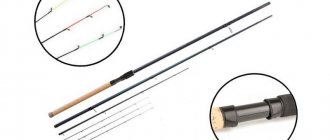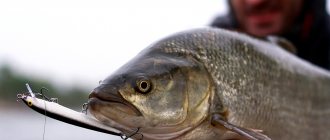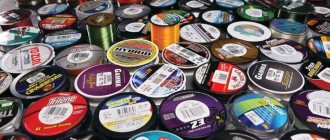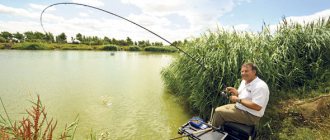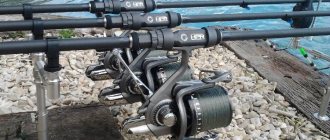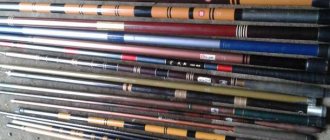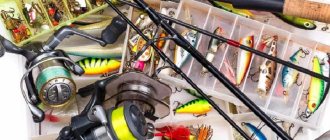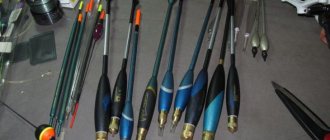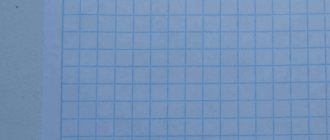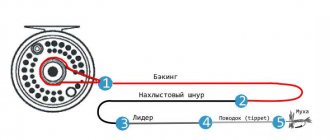"Telescope" or "plug"?
According to their design, feeder rods are divided into two types: • Telescopic feeder – a folding rod. It starts with a section of larger diameter and ends with a section of smaller diameter. This structure allows you to quickly expand or fold the feeder. For the same reason, the rod is characterized by increased structural rigidity. • Plug feeder – a collapsible fishing rod. It consists mainly of three elbows connected to each other. It is large in size and less convenient to transport. Unlike telescopic, it can be of different constructions. Experienced anglers prefer the “plug”. Its advantages include: greater convenience in the process of casting and fishing, the ability to install rings where necessary. In the “telescope”, due to the design features, the rings are installed only at the end of each section at the joints. Also, a plug rod has increased strength and is lighter than a telescopic rod. If you are choosing a feeder for infrequent amateur fishing with outdoor recreation, choose a “telescope”. It is easier to transport and store.
Advantages and disadvantages of the “telescope”
A telescopic fishing rod for feeder fishing has both its advantages and disadvantages, which should be taken into account when configuring the tackle. The main disadvantages of the “telefeeder” include:
- Heavy weight due to the use of fiberglass materials. In addition, the “telescope” manufacturing technology involves overlapping one knee over the other. This also helps to increase the weight of the product.
- Low sensitivity, which also occurs due to the large mass of the fishing rod. The fiberglass quiver tip of a heavy fishing rod standing on stands takes longer to come to a calm state after casting the equipment or a strong gust of wind, which does not allow you to see careful bites.
- A too slow action, which occurs due to the excess weight of the rod, negatively affects the accuracy of casting the feeder. A fishing rod with a slow action eliminates the possibility of high-speed fishing.
In addition, the significant weight of the “telescope” means that during active fishing, the angler’s hand quickly gets tired and fishing ceases to bring the expected pleasure. The telescopic feeder can consist of a dozen tubular elbows, and if damage occurs in any of them, the fishing can be ended. A large number of connecting connections also do not add strength to the “telefeeder”.
The main advantage of a telescopic fishing rod is its reasonable price. A high-quality fishing rod that can be successfully used for fishing medium-sized fish can be purchased at a price of 800–3000 rubles, which is much less than the cost of plug-in products.
Since the “telefeeder” is usually made of fiberglass-based composite materials, it has increased resistance to shock loads. Increased strength gives the angler the opportunity to transport the “telescope” without placing it in a hard case. Such products can be handled less carefully than high modulus graphite feeders.
The first ring of the feeder experiences increased load when casting, so it must have 2 attachment points.
It is advisable to use a retractable type feeder when it comes to leisurely fishing for medium-sized fish, when the fishing rod is on stands for most of the fishing day. In such conditions, the weight of the rod plays virtually no role.
When purchasing a “telescope” for a feeder, special attention should be paid to the integrity of all fittings, as well as to the joints of the elbows, which should not have cracks or other mechanical damage.
Feeder rod material
The feeder is made of carbon fiber or fiberglass. There are also composite fishing rods. Each of the materials has its pros and cons: • A composite fishing rod is quite durable and, if handled correctly, will serve for many years. Disadvantages include greater weight compared to other materials and stiffness. • Carbon fiber rod – preferred by experienced fishermen due to the best sensitivity. But it also has its downside - a high price. • Fiberglass rod - cheaper than carbon fiber, but less strong and reliable, and also heavier. Experienced fishermen recommend exclusively carbon fiber because of its reliability and sensitivity. In their opinion, it is better to pay once for a durable and light fishing rod than to regularly buy a new one. Experienced fishermen recommend exclusively carbon fiber because of its reliability and sensitivity. In their opinion, it is better to pay once for a durable and light fishing rod than to regularly buy a new one.
What are feeder rods?
The feeder structure consists of:
- blank (fishing rod body);
- handles;
- spool holder (reel holder);
- plug connections;
- pass rings;
- quivertypes.
Each fishing rod comes with 2-3 quivertips (replaceable tips), with different test, for fishing in a variety of conditions. Since the stiffness of the tips is different, before assembling the rod, the angler chooses the quivertype that will be more sensitive for a given body of water.
If there is a current, it is better to put a rigid tip, which, after casting the tackle, will take the correct position and signal a bite. In the absence of a current, a less rigid quiver tip is installed, which is capable of “recognizing” the most delicate bites of small fish.
Usually the tops are designated by different colors:
- yellow;
- red;
- green.
According to generally accepted rules, the green tip is the softest, and the red tip is the hardest.
The form or body of the feeder is the main part and for its manufacture the following are used:
- carbon fiber (carbon);
- composite materials;
- fiberglass.
Form
The reliability and strength of the fishing rod, as well as its weight, depend on the quality of the manufacturing material, because, say, carbon is lighter and stronger than fiberglass, but it also costs more. Considering that after throwing the feeder into the water, the rod is installed on stands, its weight may not seem to be the most important characteristic, since you do not have to constantly hold the rod in your hands.
But catching small fish on a feeder is fast, requiring frequent recasts, and if you come fishing not to pump up your muscles, but to have fun, then the weight of the form matters. Carbon fiber feeders are the strongest, but this does not mean that fiberglass or composite rods will break after the first casts.
Each form is characterized by test indicators that indicate what weight feeders should be used with it. At the same time, the cost of carbon is higher and it is not always necessary to spend money on an expensive feeder, especially if you plan to fish at short distances with light weight feeders. The fisherman chooses a feeder based on the price-quality ratio, and everyone has their own preferences.
Lever
The angler is in direct contact with the handle of the rod and it should be comfortable so that the feeder fits well in the hand.
For the manufacture of handles the following is used:
- cork;
- soft EVA material.
Cork is more durable, and EVA is more pleasant to the touch and cheaper. Both materials are quickly washed off from dirt, and this is also an important point. The handles are spaced and solid, and their length depends on the length of the feeder. The longer the feeder handle, the greater the leverage will be during casting, so long-range feeders are equipped with long handles.
Passing rings
Not all feeder fishing enthusiasts understand how important rod guides are and what they should be like. A larger number of rings than on other types of rods is an undoubted advantage of the feeder, increasing its astringent properties when playing caught fish.
The material of manufacture, design and number of rings are especially important when fishing with braided fishing lines, which exert a serious load when casting onto the ring inserts. The characteristics of any feeder must indicate the number of rings and the material of the inserts, although, unfortunately, there is no such marking on the forms.
But every reputable seller should have equipment catalogs that contain all the data, including those related to rings. For fishing with a line, you should buy feeders with silicon-coated metal-ceramic inserts (SIC).
Expensive fishing rods are necessarily equipped with rings with inserts, but in any case you need to make sure that they are there. The greater the number of rings on the form, the better, because they help distribute the load evenly. The type of fastening of the rings also deserves attention and it is better to have three legs rather than two.
Reel seats
Feeder rods are equipped with reel seats for attaching a reel.
They are:
- open rear screws;
- front screw.
Open rear screw clamps are equipped with a nut, with which the coil is firmly fixed in the stock. The front screw reel seat is essentially a decorative cover for the screw clamp. The front clamp holds the reel more securely and looks more aesthetically pleasing than the rear one. But its price is also higher, and for a long time, expensive feeder models were equipped with clamps for coils of this design.
Now the situation has changed and such clamps are also installed on budget fishing rods, but this affects their cost. The open rear lock sometimes unwinds in the fisherman’s hands, and at the most inopportune moment, and its reliability is still lower. The main task of the reel seat is to securely fix the reel, and other characteristics do not play a decisive role.
You can find out more detailed information about quivertypes in a separate article on our website.
Build
According to their structure, feeders are divided into four categories: • Fast – “Fast”. The toughest of all. Only the first leg and the top of the rod bend. • Average – “Medium”. Less rigid feeder, bends 1/6 of the rod length. • Slow – “Slow”. The softest rod, the entire body bends right up to the handle. • Complex – “Progressive”. This rod bends with its entire body, but according to an increasing principle. At the very beginning, the upper part goes to bend, and with increasing load, all other parts of the rod are gradually included in the work. The second name for such a feeder is “parabolic”. The advantage of a fast action is the ability to hook fish quickly and sharply. A slow action rod makes it easier to catch large fish. Telescopic rods come in only fast and medium action.
How to choose a feeder rod for beginners
Choosing a feeder due to the availability of quite a variety of products is a complex and painstaking process that is difficult for a novice feeder operator to cope with alone.
Important! The starting data for selecting gear with optimal parameters for fishing are: the structure of the reservoir and, in particular, the strength of the current, the size of the fish planned to be caught, the distance of supply of the rigs and their weight.
And these are only the most basic conditions for choosing a feeder. The intensity of fishing trips and the habits of the caught trophy, which contribute to the effective selection of a feeder rod, will not be superfluous initial information. Based on this kind of data, a fishing rod is selected according to a whole list of characteristics, among which primary attention is paid to: the length of the rod, the parameters of the removable tips of the tackle, the test, the structure and material of the feeder blank, the method of fastening and the sizes of the guide rings.
Form material
On sale you can find a feeder rod made of three types of material with similar properties, differing only in density, and therefore affecting the weight of the tackle form. Fiberglass fishing rods are the heaviest among the feeder rods. They are more rigid and less informative. Basically, a budget feeder is assembled from fiberglass, the form of which forgives many mistakes in the technique of a novice feeder operator.
The opposite of fiberglass in price terms is carbon fiber gear. These are light and sensitive fishing rods, but they are fragile and require careful handling. Such tackle is more suitable for an already experienced fisherman, because the operation of the blank will require high casting technique, as well as an initial material investment in the tackle.
The golden mean between the materials presented above is occupied by fishing rods made of composite combined materials. They are slightly inferior in weight to carbon fiber, superior to fiberglass in sensitivity, durable and not so high in price levels. It’s safe to say that the composite version is the best feeder rod for a beginner.
Optimal feeder rod length
The length of the blank affects the range of the fishing rod, and also contributes to the selection of optimal gear for fishing reservoirs with strong currents. You can choose a feeder according to the length of the form from a multiple of 30 cm. The countdown begins with fishing rods 2.7 meters long and ends with a length of 4.8 meters. For specific conditions and feeder fishing tactics, some manufacturers deviate from these rules and produce forms that differ in length from generally accepted measures.
The classic length range suitable for most fishing conditions is considered to be from 3.3 to 3.9 meters. These optimal feeder lengths provide high range and sensitivity, allow you to fish with various types of rigs and confidently cope with landing large fish.
Rod test and feeder classes
The test is an important characteristic of the form, indicating the limit of the load-carrying capacity of the gear.
Important! The test parameter must be indicated by markings on feeder rods.
The weight of the thrown equipment should not exceed the recommended limits. Limits are usually divided into corresponding classes, knowing the ranges of which you can quickly select the optimal gear for fishing conditions based on this parameter.
Feeders are divided into the following classes:
- Installations whose weight does not exceed 30 grams can be fed with a light feeder .
- It is optimal to throw feeders weighing up to 60 grams with a medium-light .
- medium fishing rod is designed for casting rigs from 60 to 80 grams.
- medium-heavy class means that the whip is optimal for fishing with rigs weighing from 80 to 100 grams.
- Heavy feeders provide the feeder with casting equipment from 100 to 120 grams.
- Heavy models of the extra-heavy are designed for fishing with feeder weights over 120 grams.
Exceeding the recommended numerical values is fraught with creases in the quiver tip of the fishing rod and radically affects the range of the feeder.
What should the system be like?
The structure of the tackle characterizes its sensitivity and information content, depending on the rigidity of the blank. In the fishing environment, it is customary to divide this characteristic into three main types: fast, medium and slow. In turn, each of the three main types is divided into subtypes that more accurately characterize the parameter. Fast action is the most sensitive and informative, but this kind of forms, due to their increased rigidity, do not work well when fishing for especially heavy trophies. Slow action, on the contrary, copes quite well with compensating for excess loads during fishing, but such whips do not have a long range and are poorly informative.
Closer to universal, a feeder fishing rod with a medium action is considered. The parameters of this type of form have balanced performance characteristics that can give you a good feel for the connection, and also not be afraid for the comfortable hauling of the trophy. It is recommended for a beginner in feeder fishing to purchase just such medium-action rods, ranging from the medium class to the heavy feeder classification.
Comfortable handle
The most common in retail chains are feeders with cork or neoprene handles. The practice of bottom fishing using the feeder method shows that neoprene handles are the most efficient in use. The weight of a neoprene handle is only slightly different from the weight of the same type of cork product, and in terms of ergonomics and tactility, the difference in materials is small, but neoprene does not absorb moisture and is an elastic material in structure that can withstand significant deformations, which become critical for cork, causing it to crumble.
By type, handles are divided into solid and spaced types. The spaced type indicates the long range of the rod and its powerful component. For example, the vast majority of models in the extra heavy feeder class have a split handle.
Guide rings on the rod
All feeder rod blanks are equipped with guide rings designed to secure the cord and evenly distribute the load that occurs during casting and retrieving the trophy. The number of rings depends on the length of the feeder rod and its power. The guide rings increase in diameter from the quiver tip to the butt of the tackle; moreover, their mounting supports or legs can be made in a reinforced version, when instead of a pair of elements, the ring is connected to the blank with three supports. The ring inserts also differ in the type of material.
Important! Ceramic liners are considered the most reliable options for the inner part of the rings.
They have zero roughness, minimizing the friction force of the cords when casting. In addition to ceramics, the liner can be made of corrosion steel or plastic. Plastic is the cheapest and most unreliable type of material for a ring insert. A blank with such rings has a low rating among feeder rods; it quickly renders the monofilament or braided rod unusable, and it is better for the fisherman to refuse to purchase such equipment, preferring to choose inserts made of metal or ceramic.
Quivertypes and their role
A real and high-quality feeder rod is equipped with a replaceable set of quivertips or working tips, which differ in the amount of rigidity. Depending on this parameter, the working elements are painted in different colors, most often red, yellow and green, to quickly visually determine their characteristics.
The main functions of the quiver tip are to absorb the jerks of the fish being caught, as well as to signal a bite. Soft and sensitive tips are suitable for fishing in standing and low-flowing water bodies. Tips of medium hardness are designed for fishing in windy weather and moderate currents. Tough, as feederists say, oak quivertips are used for strong traction and at great fishing depths. Sometimes, under such extreme conditions, anglers use a conventional spinning rod for feeder fishing, where the end of the tackle form reacts to a bite.
Feeder test
The test refers to the weight of the casting gear with the feeder. Depending on the test, rods are divided into classes: • “Light” – casting weight of the tackle is 30 grams • “Medium Light” – casting weight of the tackle is 60 grams • “Medium” – casting weight of the tackle is from 60 to 80 grams • “Medium Heavy” – castable tackle weight from 80 to 100 grams • “Heavy” – casting tackle weight from 100 to 120 grams • “Extra Heavy” – casting tackle weight over 120 grams Experienced fishermen recommend choosing a fishing rod with a small “margin” from the planned weight of the casting tackle.
Most popular models
There are both domestic and foreign companies on the fishing market, in whose catalogs you can find telescopic rods for feeders. The products of some companies deserve special attention because they have received positive reviews from a large number of fishermen.
Kaida products
Kaida products have always been distinguished by their affordable prices and high build quality. The most popular telescopic feeder rods from this company include several models.
Kaida Travel 3 m
Kaida Travel 3 m is a three-meter rod that is perfect for fishing for carp and crucian carp in small ponds. Its relatively short length allows it to easily move along the shore in search of a promising place. With a short “telefeeder” you can fish in a reservoir with heavily overgrown banks, where long rods are useless.
Kaida Travel has a test weight from 60 to 100 g. This makes it possible to throw heavy feeders with a large amount of food, which is necessary when fishing for carp. The Spirado blank is made of IM6 carbon fiber, which has high strength characteristics and relatively low weight. This “telescope” is equipped with SIC fittings, which allows you to use “braid” for fishing without fear of damaging the rings.
The composite handle is made of synthetic cork with neoprene inserts. Travel is equipped with two interchangeable quivertypes with different test ranges. The rod comes in a textile case and has a transport length of 0.75 m.
Kaida Tornado 3.9 m
Kaida Tornado 3.9 – the test range of this fishing rod is limited to 130 grams, which means that this model is designed for casting very heavy feeders and landing trophy fish. The almost four-meter length allows you to easily throw the feeder 50–70 m from the shore. Tornado 3.9 m has proven itself well when catching the following fish:
- carp,
- large bream,
- grass carp,
- crucian carp
This model can be used both in reservoirs with standing water and in conditions of moderate and strong currents. Its assembled length is 1.18 m and weighs 426 g, which is quite light for rods in this segment. The Tornado blank is made of a composite material based on carbon fiber and M8 carbon. The rod is equipped with three interchangeable tips of different test.
Kaida Big Fish 4.2 m
Kaida Big Fish 4.2 m is the longest “telefeeder” produced by this company. The large length ensures long-distance casting of the feeder over a distance of more than 80 m, which is necessary if fishing takes place in a reservoir where promising places for fishing are located at a considerable distance from the shore. In addition, the long form allows you to avoid the feeder getting caught when fishing on steep underwater edges.
With a length of 4.2 meters, Big Fish has a weight of 441 g and a test range of up to 120 g. The long, spaced handle of the rod indicates that it is intended for power casting equipment over long distances. It is equipped with two replaceable tips and a fabric cover that protects the joints of the knees from sand and dust.
"Telefeeders" from
Russian products are well known to the vast majority of fishermen. This company produces feeder rods of various classes, which can be used for effective fishing by both sports fishermen and amateurs. Of the “telescopes” produced by this company, two models can be distinguished, which are most often found in the arsenal of feeders.
“Volzhanka Telefeeder” 3.3m
The Volzhanka Telefeeder 3.3m model is designed for fishing large fish. This “telescope” is often used by fishermen who like to go fishing in the lower reaches of the Volga, where there are a lot of large carp and grass carp. There are cases when this fishing rod managed to pull out carp weighing more than 10 kg.
This model is made of IM7 carbon fiber and has an upper test limit of 150 g, which allows you to fish in very strong currents where it is necessary to use heavy feeders. The rod's guide rings have an increased diameter and SiC liners. The elements of the spaced handle are made of synthetic material with good thermal insulation and anti-slip properties.
The slow action of the blank gives the rod excellent casting characteristics and makes it possible to confidently fight with large fish. “Volzhanka Telefeeder” 3.3 m is equipped with three fiberglass quivertypes of varying degrees of rigidity. Its transport length is 97 cm and weighs 320 g.
Feeder rod length
When choosing the length of the feeder, you should take into account the conditions under which the fish will be caught. Conventionally, rods can be divided into: • “Light” – rod length up to 3.3 meters, casting distance up to fifty meters. These feeders are designed for fishing on medium-sized ponds and lakes, as well as rivers with weak currents. • “Medium” – rod length 3.6 meters, casting distance up to sixty meters. These feeders are more universal, designed for fishing on lowland rivers, as well as reservoirs, ponds and lakes. Also suitable for fishing from a boat. • “Heavy” – rod length from 3.9 to 4.2 meters, casting distance up to eighty meters. These feeders are designed for fishing on large lakes and rivers with power casts over long distances of heavy tackle. • “Super heavy” – the length of the rod in some models exceeds five meters, the casting range is over one hundred meters. Used for ultra-long casting of the heaviest tackle. Short rods are called picker rods. Pickers are divided into: • “Ultralight” and “light” – length up to 2.4 meters, test from 3 to 20 grams. • “Medium” – length from 2.4 to 2.7 meters, test from 30 to 40 grams. • “Heavy” – length up to 3 meters, test from 100 to 110 grams.
Tips and recommendations when choosing feeders from Aliexpress
To purchase a good feeder for your requirements on Aliexpress, you need to understand how to navigate the variety of options presented. In this case, it is worth paying attention to two points - the manufacturers and the characteristics of the gear.
Types of feeders
When choosing a feeder rod, first of all you should pay attention to the design.
| Feeder rod type | Who is it suitable for? | Advantages | Flaws |
| Telescopic | Beginners, undemanding anglers | Compact when folded and low price | Construction, working qualities |
| Plug multi-gang | Intermediate fishermen | Compactness when disassembled, structure and performance properties are better than telescopic ones | Construction, working qualities |
| Plug-in classic (three-arm) | Advanced Anglers | Best action and excellent performance | Takes up a lot of space when disassembled, difficult to transport |
Video - Types of feeder rods
Thus, from these three options for feeder designs, you can choose the one that suits your needs.
Note! If you have to fish infrequently and don’t want to spend a lot of money, then a telescopic fishing rod will do. For serious fishing, on the contrary, it is definitely worth taking a classic three-legged feeder. This rod will allow you to fish as efficiently as possible and with the best comfort.
The length of feeder rods ranges from 3 to 4.5 m. The greater the required casting distance, the higher this parameter should be. The most universal options are sizes of 3.6 and 3.9 m. These are the rods you can choose if the conditions in which you will be fishing are still unknown, as well as in cases where you want to get gear that is optimal for fishing in a variety of situations .
Feeder tests - from 40 to 150 g. Lighter and heavier rods are also sometimes used. When choosing a feeder based on this parameter, you need to proceed from the depth and strength of the current at the fishing site, the required casting distance, as well as the size of the fish that you intend to catch. The higher these parameters, the larger the test should be. The most universal are gears with test weights from 80 to 120 g.
Note! Beginners should choose feeders with more tests. In this case, the risk of the rod breaking during casting or when retrieving is minimized. The downside of large tests is the reduced sensitivity of the sticks. But for novice feeders this is not a significant disadvantage, such as an increased risk of gear breakage.
Video - How to buy a good feeder, choosing a feeder rod for a beginner
Choosing a telescopic spinning rod. What to pay attention to
If the choice nevertheless falls on a telescopic rod, you should pay attention to the following details: • The rod test should be with a margin of the planned weight of the gear being cast. Since the telescopic feeder is less durable and reliable than the plug-in feeder, it is necessary to have a safety margin. • No play when unfolded. All knees after the rod is unfolded should stay tightly and rigidly in place. • Feeder material. Since the “telescope” is less reliable due to its design features, pay attention to the quality and reliability of the material. • Ring quality. Be sure to pay attention to this. The rings must be strong, securely fastened and absolutely smooth for the line to flow freely from the reel. • Reel holder. No backlash. The attached reel should sit tightly and securely in the holder.
The best manufacturers of telescopic feeder rods
Now we will present the five best manufacturers of telescopic feeder rods, whose products have gained great popularity.
Mikado
Good value for money. Telescopic models: • SILVER EAGLE TelePicker – length from 3 to 3.3 meters, test from 20 to 60 grams. Price: 1000 rubles. • FISH HUNTER TelePicker – length from 2.7 to 3.3 meters, test from 20 to 60 grams. Price: 900 rubles.
Salmo DIAMOND TELE FEEDER
It produces models in different price categories, from luxury to budget. The telescopic feeder is represented by the DIAMOND TELE FEEDER model - length 3.3 meters, test 120 grams. Price: 1600 rubles.
Daiwa
It produces feeder rods of excellent quality, in a telescopic version it produces the model TRIFORCE TELE FEEDER TF LG R 36T-AI - length 3.6 meters, test from 10 to 60 grams. Price: 2000 rubles.
Shimano
It produces good fishing rods of various models designed for the average price category. All fishing rods of this brand have earned high praise among anglers. Telescopic models: • Aernos Tele Feeder – length from 3.66 to 3.96 meters, test from 60 to 90 grams. Price: 6300 rubles. • VENGEANCE TELE FEEDER HEAVY – length 3.9 meters, test 110 grams. Price: 5500 rubles. • VENGEANCE TELE FEEDER MEDIUM – length 3.6 meters, test 100 grams. Price: 5300 rubles.
Differences between a telescopic feeder and a plug feeder
When purchasing a telescopic feeder rod, an angler must understand that it is unlikely to have the same performance characteristics as plug-in models. Compact retractable feeder rods are not designed for high-speed fishing of small fish, which is most often practiced in competitions, because they have a large mass and are not fast enough.
The telescopic option is better suited for those anglers who are just starting to master feeder fishing and prefer to catch the following fish:
- crucian carp,
- carp,
- tench,
- bream.
The length of “telescopes”, as a rule, is slightly longer than the length of plug-in products, and starts from 3.2 m. Unlike professional feeders, retractable fishing rods are rarely made of high-modulus graphite. The main material for making the blank is fiberglass, which is why the mass of the “telescope” is significantly greater than the weight of the “plug”. The handle of retractable fishing rods is often made of synthetic materials, rather than cork, like plug-in models.
The fittings that the “telescopes” are equipped with are inferior in quality to those used in two-piece fishing rods, so you will have to abandon the use of very thin “braid”. A thin braided cord will quickly damage the guide rings, and fishing will become impossible. For fishing with a telescopic feeder, a rigid monofilament line with a low stretch coefficient or a “braid” with a diameter no thinner than 0.12 mm is better suited. Among retractable feeder rods, there are rarely those whose actual test weight is less than 40 g, which requires the use of rather heavy feeders.
Almost all “telefeeders” are equipped with replaceable tips made of fiberglass. Fiberglass quivertypes have a large mass. This negatively affects the sensitivity of the gear.
Results
In conclusion, we will give some tips.
Once you have decided on the necessary characteristics of the feeder rod, material and brand, do not rush to buy it right away. Don’t rely only on the seller’s words, do a couple of simple tests for yourself: • Take the unfolded fishing rod in your hand. The grip should be comfortable for you personally. • Holding the rod in your hand, make movements that simulate casting, feel in practice the elasticity of the feeder, choose the one that you like best. • Visually carefully inspect and feel the rod for defects. When choosing a feeder, remember - the stingy pays twice. Source
